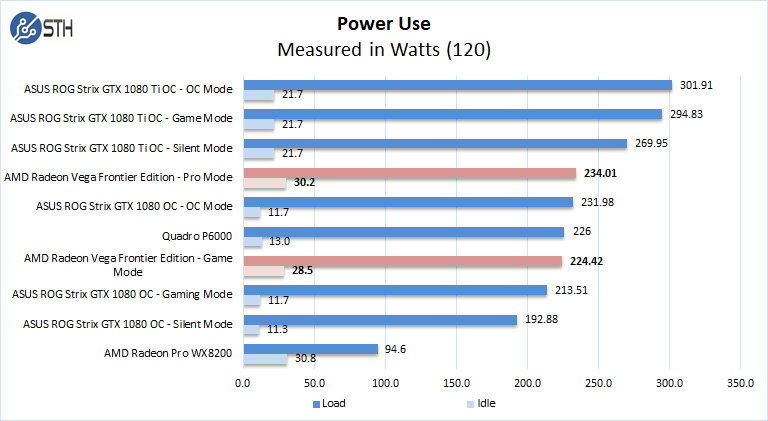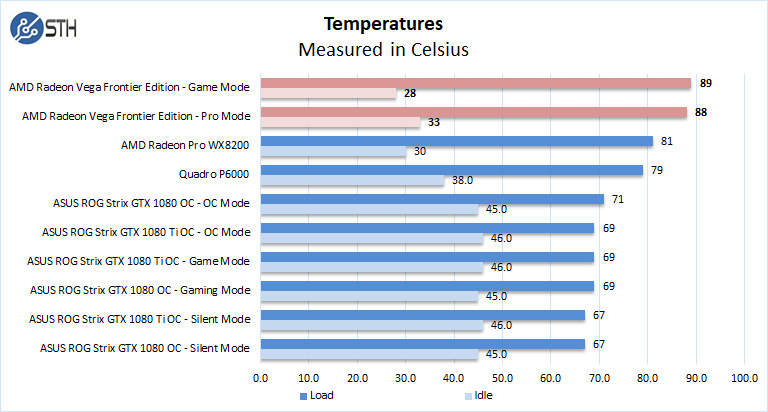Power and Temperature Tests
For our power testing, we used AIDA64 to stress the Vega FE, then HWiNFO to monitor power use and temperatures.

After the stress test has ramped up the Vega FE for a length of time, we find the GPU goes from 30.2 Watts at idle and ramps up to 234.01 Watts at full load using the Pro Drivers. With the Gaming Drivers, we see 28.5 Watts at idle and 224.42 Watts at load.

Temperatures for the Vega FE using the Pro Drivers start at 33C at idle and 88C at full load, while the Gaming Drivers come in at 28C at idle and 89C at full load. That is fairly warm compared to other offerings we are testing.
Conclusion
Like the AMD Radeon Pro WX 8200, the AMD Radeon Vega Frontier Edition 16GB is powerful when running OpenCL applications like Radeon ProRender, Blender, Maya, and Adobe Premiere Pro and other Vega certified apps. Looking at our charts, we see it is the highest performing OpenCL GPU we have tested yet. The Vega FE beats out much more expensive GPU’s from the green team.
We found the Vega FE to be moderate in power use; however, it is the warmest graphics card we have tested with 89F temps at full load. Temps can be mitigated by ramping up the fan to full speeds; the side effect is the noise levels which are very high and something you would tire of easily. In a remote server, like our DeepLearning11 build, this would be fine. Fan noise is typical for blower type GPU’s so the high noise levels are not unexpected, this would not be a problem when running in a remote location or a server located in a DC or server room.
Most will compare the Vega FE with high-end cards such as the Quadro P5000, P6000 and Titan XP. While workloads will dictate which GPU’s you decided to use, for OpenCL workloads, the Vega FE will net you the best bang for your buck and easily outperforms the other cards at a much lower price point.
Originally the Vega FE’s retail price was above $1,000 but now can be found for less than half that post-crypto crash. That changes the calculus here making this card a very affordable graphics card and fast for the price. If you wanted to use FreeSync for faster refresh rates, you end up saving on the monitor side as well versus NVIDIA G-Sync. There is a lot of benefits here.
Perhaps later in its lifecycle, we see the AMD Radeon Vega Frontier Edition 16GB card to be a unique value proposition for those that prefer AMD tooling over NVIDIA for their setups.




You are pretty late with a review of this great GPU
“AMD Radeon Vega Frontier Edition 16GB Review by Igor Wallossek August 2, 2017 at 6:00 AM ”
at tomshardware.
Better late than never…
We have 3 of them, 1 standard and 2 watercooled.
For us the biggest features where 10 bits color overlay in OpenCL, 16 GB VRAM and HBCC (we use it for photo and video editing in Resolve and Adobe software.)
newegg had the liquid cooled version for $599 recently. Do you know if there are any pass-thru/sr-iov capability for vmware?
I thought for a moment this is first look at the 7nM Vega.
I’m starting to think Mi60 must be renamed Mia60 :-(
I don’t think this one has ECC memory support (as the review suggests). Also these Vega cards really get a lot better if they’re tuned properly. The “graphics related benchmarks” here, for example, show the card is noticeably slower than GTX 1080. But that’s most likely due to heavy throttling you’ve had – if you’d look at the clocks your Vega FE was running at during those tests, you’d see that they were nowhere near the stock 1600/945. In order to get decent results from these cards, they need to be undervolted and properly cooled. For example, my Vega FE card is rock solid stable at 1500/1100 @ 1.0V. But the stock voltage is 1.2V, and at that voltage the air-cooled card is throttled by both thermal limits and power limits (it just won’t work at 1600@ 1.2V with the stock TDP limit and air cooler, so it drops the clocks significantly). Ideally these cards need to be flashed with the LC version BIOS (which has higher powerlimit) and cooled with full-cover water blocks (or RAIJINTEK MORPHEUS at least). That’s when they actually start to perform well (equal or even faster than GTX 1080). Pascal cards are good out of the box and can’t really be pushed all that much, but Vega’s greatly benefit from tuning cause they can gain 10-20% compared to stock.